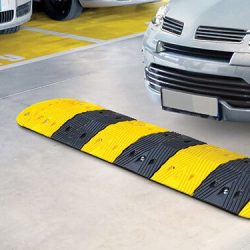Parking lots are an important part of our daily lives, but they can also present safety risks for drivers and pedestrians. Fortunately, there are effective, low-maintenance solutions to improve parking safety, one of them being speed humps. In this article, we will explore how speed bumps can help improve parking safety and can also have a positive impact on insurance premiums for parking lot owners. Safety and cost savings are two important issues for parking lot owners, and speed bumps are an effective way to address both issues. Read on to find out more about this topic.
What are speed bumps?
Speed bumps are devices designed to force drivers to slow down in parking lots. These devices can come in different forms, such as humps, bumps, or bullbacks, and work by creating a raised surface on the road, forcing drivers to slow down to pass over them. Speed bumps are highly effective in reducing vehicle speeds in parking lots, which in turn improves safety for pedestrians and other parking users. There are different types of speed bumps available on the market, including speed bumps, plastic speed bumps and rubber speed bumps, each with their own features and benefits.Parking safety
Parking safety is an issue of great importance to drivers and parking lot owners. Unfortunately, parking lots are often places prone to accidents and injuries due to speeding vehicles. Fortunately, speed bumps are an effective solution for improving parking safety. These devices force drivers to slow down when entering and exiting the parking lot, significantly reducing the risk of accidents. Additionally, by reducing the speed of vehicles in the parking lot, the possibility of collisions between vehicles and pedestrians is also reduced. According to statistics, it is estimated that 20% of traffic accidents occur in parking lots. By installing speed bumps, parking lot owners can help reduce the number of accidents and injuries on their property. Not only is this beneficial for drivers and pedestrians, but it can also save money on costly insurance claims. In short, installing speed bumps in parking lots can make a big difference in the safety of drivers and pedestrians. Additionally, as we will see below, it can also result in savings on insurance premiums for parking lot owners. Therefore, it is important to consider installing these devices in any parking lot to ensure a safer environment for everyone.Savings on insurance premiums
Speed bumps not only improve parking lot safety, but they can also help reduce insurance premiums for parking lot owners. Several studies have shown a correlation between the installation of speed bumps and a decrease in accidents in parking lots. This means that safer parking can result in lower insurance premiums. Additionally, by slowing vehicles in the parking lot, speed bumps can help prevent accidents and property damage, which in turn can result in lower costs for owners in terms of repairs and insurance claims. . Installing speed bumps is not only an important safety measure, but also a way to save money in the long run. Considering the installation of these devices can help reduce insurance costs and improve parking profitability.Types of speed reducers
Speed bumps come in different shapes and sizes, each with their own features and benefits. Below, we will mention the most common types of speed bumps available on the market and their pros and cons.Speed ramps:
- They are the most common type and consist of a raised surface that forces vehicles to reduce speed.
- Pros: They are inexpensive and easy to install.
- Cons: They can cause inconvenience to drivers and damage to vehicles if not installed correctly.
Bollards:
- They consist of pillars of metal placed on the ground to force vehicles to follow a specific route.
- Pros: They are highly effective in reducing speed.
- Cons: They can be expensive and difficult to install.
Donkey loins:
- They are a series of small elevations in the ground that force vehicles to reduce their speed.
- Pros: They are inexpensive and easy to install.
- Cons: May not be as effective at reducing speed as other types of reducers.

